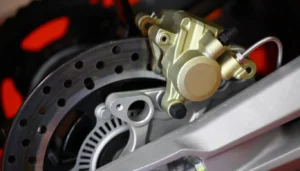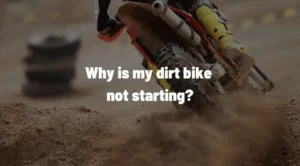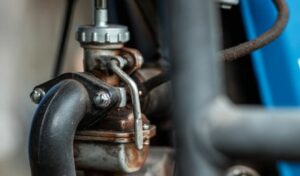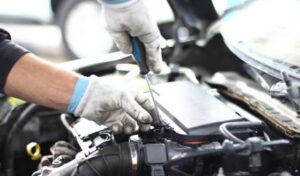Fuel leaks are a common issue with dirt bikes. These issues can sometimes happen since these bikes are so durable and tenacious. You can run into problems if you are not aware of the causes of gas leaks on a dirt bike.
If you ignore these 7 causes of dirt bike gas leakage then you will not be able to fix the issue.
Gas leaks are really annoying. You can tell if your bike is leaking gas when you can see fuel dripping from it onto the ground.
As quickly as you can fix it because it might burn up all of our gas in a single night. There are numerous causes for the gas leakage issue.
Today I’m going to discuss different reasons for gas leaks in dirt bikes.
Why Is My Dirt Bike Leaking Gas?
Several factors can cause a dirt bike to leak gas. A broken fuel switch, carburetor overflow, fuel bowl, or carburetor drain screw are some of the most common reasons why gas leaks from dirt bikes. For this task or any engine work, no technical knowledge is required; all of these parts can be fixed easily with a few basic tools.
Here are the seven causes of gas leaks on dirt bikes:
- Damaged fuel switch
- Carburetor overflow
- Fuel leakage from the float bowl
- Leakage from carburetor drain screw
- Needle Dirt
- Cracked Fuel Line
- Boiling over Gas
Reasons for Dirt Bike Gas Leakage with Fixes
Here, we’ll figure out how to mend a motocross bike’s leaking gas tank. I’ve already gone over the 7 most common causes of gas leaking from a dirt bike. I’ll start by naming the components and then go over each one in turn.
Another major problem with dirt bikes is oil leakage, which you can understand by reading the article why does a dirt bike leak oil?
1. Damaged Fuel Switch
A faulty fuel switch is sometimes to blame. Below the gas tank, you will find the fuel switch. A switch with a pipe leading to it may be seen.
When the pipe becomes slack enough, gas can escape.
It is possible to activate and deactivate the gas transport mode using this switch. It’s a minor component that may be obtained from numerous stores on the web.
You should probably just replace the whole thing. From this vantage point, you can begin your search for the appropriate component.
2. Carburettor overflow
Look at the overflow in the carburetor. There could be a float valve issue if gas is escaping through the carburetor overflow.
In case the float valve is stuck, check it out. When this valve gets dirty, it can become stuck.
The level of gas in a carburetor is sensed by a float bowl, which rises or falls as necessary. The plunger is linked to the float in this setup.
There will be no more unnecessary fuel being poured into the receptacle. The gas leak occurs when the plunger is disconnected from the float valve.
Verify that the float valve’s plunger is properly seated. To fix the problem, take the carburetor off your bike and take off the float bowl. The problem can be easily fixed.
Cleaning the float bowl after removing it is optional. Tap the carb bowl with a screwdriver handle to test whether the obstruction to the valve closing is dislodged.
3. Fuel leakage from the float bowl
An additional source of gas loss on your dirt bike is the float bowl. These leaks progress slowly and can be difficult to spot.
You’ll need some time to investigate the issue and find a solution. This is because there is no obvious gas leak in these areas, and they are moist and greasy.
You’ll need to rotate the screw by 90 degrees to gain access to it. In addition, the carburetor can be removed from the motorcycle in order to facilitate quick and simple repairs.
The next step is to take out the float bowl screws and inspect the gasket and carburetor housing closely. Gaskets are typically compact and take the form of a business card.
Indicators of a worn gasket include grime and a rough surface. Simply buy a new one and install it.
The procedure of detaching and reattaching will teach you how to do both.
The good news is that the bike has a carburetor rebuild kit included, and the bowl in the carburetor always floats. All you have to do is pull it out and put the original back in.
The float bowl of a gasket carburetor is secured by four screws. This loosening occurs for no apparent cause at times. First, I made sure the gasket was brand new, and then I tightened the four screws.
4. Carburetor drain screw
Every carburetor on a dirt bike has a drain at the very bottom. This drain is where any fuel that leaks out can go.
However, there are instances where it can lead to a gas leak and subsequent harm. If you haven’t filled up in a while the gas may leak from the screw part of the engine.
This problem can be fixed by replacing the gasket that seals the screw to the float bowl.
In order to find a repair kit, you may either visit a physical store or do some online searching.
As an added bonus, some collections include an extra screw for the drain nozzle. You can even replace it with something completely different.
Keep in mind that certain carburetors do not have a screw in their drain system. As I mentioned earlier, you may either replace it or patch the gasket if you find a big, bold head there.
Additional If all else checks out, verify the gasoline line between the carburetor and the fuel valve. Check to see if the ring is properly in place and if there is no gas leaking from the joint.
Issues can arise from the age and durability of a fuel line. It could be time to get a new pipe altogether.
The ethanol-fix gas has significantly weakened these pipes. For this reason, it’s a good idea to keep several spare pipes on hand.
Check out our article about how to clean the carburetor on a 4-stroke dirt bike!
5. Needle Dirt
The float bowl and pin are linked to the needle and seat, which prevent gas from entering the carb until it is needed.
Gas will continue to flow into the carb bowl and begin to escape via the overflow tube if the needle and seat are dusty or damaged.
This may be a part that can be cleaned, but if the issue persists, it will need to be replaced. Since spares are cheap and don’t take up much room, they’re worth keeping on hand.
6. Tank Holes
Large gas leaks can be caused by holes in a dirt bike’s gas tank, which are uncommon but usually simple to identify. The impact from something like a branch or a sharp pebble can cause holes.
Abnormal erosion or corrosion can also cause holes. A tiny opening is all that’s needed for the gas to escape and fill the room.
7. Boiling over Gas
When gas is brought to a high enough temperature, it will begin to boil and bubble. The overheated engine is to blame for this problem.
Where does the engine’s heat go, given that it is typically located below the petrol tank on dirt bikes?
Yes, when the engine is warm, the gas tank also begins to warm up. When the engine temperature rises too high for too long, the gas in the tank can begin to fry.
Is there anything you can do to keep the gas from coming to a head?
There are a few options for maintaining a cooler gas temperature. If this keeps happening, engine cooling should be a top priority.
If you are going to fix the gas leak on a dirt bike, then you will need more detailed information. That’s why I wrote another whole article on fixing the gas leak. You can read my article on how to fix a gas leak on a dirt bike.
Conclusion
Upon completion of these checks and repairs, your bike will no longer be leaking gas. Look through the gasket, fuel valve, float bowl, and pipes, and you’ll be ready to fix your dirt bike anywhere.
A trip to the garage is never recommended for such minor problems. Simple maintenance can eliminate a gas leak on a dirt bike. If you take it to the garage, they will charge you too much money that you don’t have. Because of this, you should train yourself to deal with gas leaks.
Sources: Does your dirt bike leak gas?






